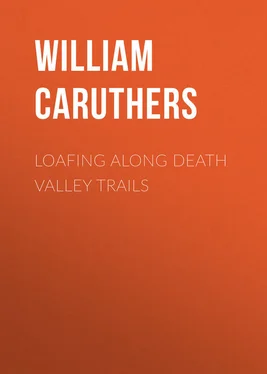William Caruthers - Loafing Along Death Valley Trails
Здесь есть возможность читать онлайн «William Caruthers - Loafing Along Death Valley Trails» — ознакомительный отрывок электронной книги совершенно бесплатно, а после прочтения отрывка купить полную версию. В некоторых случаях можно слушать аудио, скачать через торрент в формате fb2 и присутствует краткое содержание. Жанр: foreign_language, foreign_prose, на английском языке. Описание произведения, (предисловие) а так же отзывы посетителей доступны на портале библиотеки ЛибКат.
- Название:Loafing Along Death Valley Trails
- Автор:
- Жанр:
- Год:неизвестен
- ISBN:нет данных
- Рейтинг книги:5 / 5. Голосов: 1
-
Избранное:Добавить в избранное
- Отзывы:
-
Ваша оценка:
- 100
- 1
- 2
- 3
- 4
- 5
Loafing Along Death Valley Trails: краткое содержание, описание и аннотация
Предлагаем к чтению аннотацию, описание, краткое содержание или предисловие (зависит от того, что написал сам автор книги «Loafing Along Death Valley Trails»). Если вы не нашли необходимую информацию о книге — напишите в комментариях, мы постараемся отыскать её.
Loafing Along Death Valley Trails — читать онлайн ознакомительный отрывок
Ниже представлен текст книги, разбитый по страницам. Система сохранения места последней прочитанной страницы, позволяет с удобством читать онлайн бесплатно книгу «Loafing Along Death Valley Trails», без необходимости каждый раз заново искать на чём Вы остановились. Поставьте закладку, и сможете в любой момент перейти на страницу, на которой закончили чтение.
Интервал:
Закладка:
One day while resting his team, Stiles noticed a patch of tules growing a short distance off the road and taking a shovel he walked over, started digging a hole on what he thought was a million to one chance of finding water, and thus reduce the load that had to be hauled for use between springs. “I hadn’t dug a foot,” he told me “before I struck water. I dug a ditch to let it run off and after it cleared I drank some, found it good and enlarged the hole.”
He went on to Daggett with his load. Repairs to his wagon train required a week and by the time he returned five weeks had elapsed. “I stopped the team opposite the tules, got out and started over to look at the hole I’d dug. When I got within a few yards three or four naked squaw hags scurried into the brush. I stopped and looked away toward the mountains to give ’em a chance to hide. Then I noticed two Indian bucks, each leading a riderless horse, headed for the Panamints. Then I knew what had happened.”
Ed Stiles was a desert man and knew his Indians. Somewhere up in a Panamint canyon the chief had called a powwow and when it was over the head men had gone from one wickiup to another and looked over all the toothless old crones who no longer were able to serve, yet consumed and were in the way. Then they had brought the horses and with two strong bucks to guard them, they had ridden down the canyon and out across the desert to the water hole. There the crones had slid to the ground. The bucks had dropped a sack of piñon nuts. Of course, the toothless hags could not crunch the nuts and even if they could, the nuts would not last long. Then they would have to crawl off into the scrawny brush and grabble for herbs or slap at grasshoppers, but these are quicker than palsied hands and in a little while the sun would beat them down.
The rest was up to God.
The distinction of driving the first 20 mule team has always been a matter of controversy. Over a nation-wide hook-up, the National Broadcasting Co. once presented a playlet based upon these conflicting claims. A few days afterward, at the annual Death Valley picnic held at Wilmington, John Delameter, a speaker, announced that he’d made considerable research and was prepared to name the person actually entitled to that honor. The crowd, including three claimants of the title, moved closer, their ears cupped in eager attention as Delameter began to speak. One of the claimants nudged my arm with a confident smile, whispered, “Now you’ll know…” A few feet away his rivals, their pale eyes fixed on the speaker, hunched forward to miss no word.
Mr. Delameter said: “There were several wagons of 16 mules and who drove the first of these, I do not know, but I do know who drove the first 20 mule team.”
Covertly and with gleams of triumph, the claimants eyed each other as Delameter paused to turn a page of his manuscript. Then with a loud voice he said: “I drove it myself!”
May God have mercy on his soul.
A few days later I rang the doorbell at the ranch house of Ed Stiles, almost surrounded by the city of San Bernardino. As no one answered, I walked to the rear, and across a field of green alfalfa saw a man pitching hay in a temperature of 120 degrees. It was Stiles who in 1876 was teaming in Bodie – toughest of the gold towns.
I sat down in the shade of his hay. He stood in the sun. I said, “Mr. Stiles, do you know who drove the first 20 mule team in Death Valley?”
He gave me a kind of et-tu, Brute look and smiled.
“In the fall of 1882 I was driving a 12 mule team from the Eagle Borax Works to Daggett. I met a man on a buckboard who asked if the team was for sale. I told him to write Mr. McLaughlin. It took 15 days to make the round trip and when I got back I met the same man. He showed me a bill of sale for the team and hired me to drive it. He had an eight mule team and a new red wagon, driven by a fellow named Webster. The man in the buckboard was Borax Smith.
“Al Maynard, foreman for Smith and Coleman, was at work grubbing out mesquite to plant alfalfa on what is now Furnace Creek Ranch. Maynard told me to take the tongue out of the new wagon and put a trailer tongue in it. ‘In the morning,’ he said, ‘hitch it to your wagon. Put a water wagon behind your trailer, hook up those eight mules with your team and go to Daggett.’
“That was the first time that a 20 mule team was driven out of Death Valley. Webster was supposed to swamp for me. But when he saw his new red wagon and mules hitched up with my outfit, he walked into the office and quit his job.”
Chapter VI
Death Valley Geology
The pleasure of your trip through the Big Sink will be enhanced if you know something about the structural features which are sure to arrest your attention.
For undetermined ages Death Valley was desert. Then rivers and lakes. Rivers dried. Lakes evaporated. Again, desert. It is believed that in thousands of years there have been no changes other than those caused by earthquakes and erosion.
It is no abuse of the superlative to say that the foremost authority upon Death Valley geology is Doctor Levi Noble, who has studied it under the auspices of the U.S. Geological Survey since 1917. He has ridden over more of it than anyone and because of his studies, earlier conclusions of geologists are scrapped today.
From a pamphlet published by the American Geological Society with the permission of the U. S. Dept. of Interior, now out of print, I quote a few passages which Doctor Noble, its author, once described to me as “dull reading, even for scientists.”
“The southern Death Valley region contains rocks of at least eight geologic systems whose aggregate thickness certainly exceeds 45,000 feet for the stratified rocks alone.”
“The dissected playa or lake beds in Amargosa Valley between Shoshone and Tecopa contain elephant remains that are Pleistocene…”
“Rainbow Mountain is one of the geological show places of the Death Valley region… Here the Amargosa river has cut a canyon 1000 feet deep… The mountain is made up of thrust slices of Cambrian and pre-Cambrian rocks alternating with slices of Tertiary rocks, all of which dip in general about 30 to 40 degrees eastward, but are also anticlinally arched.”
“None of the geologic terms in common use appear exactly to fit this mosaic of large tightly packed individual blocks of different ages occupying a definite zone above a major thrust fault.”
The significant feature is that a stratum that began with creation may lie above one that is an infant in the age of rock – a puzzle that will engage men of Levi Noble’s talents for years to come. But one doesn’t have to be a member of the American Geological Society to find thrills in other gripping features.
Throughout the area south of Shoshone are many hot springs containing boron and fluorine – some with traces of radium. The water is believed to come from a buried river. The source of other hot springs in the Death Valley area is unknown.
More startling features were related to Shorty Harris and me at Bennett’s Well in the bottom of Death Valley where we met one of Shorty’s friends. Lanky and baked brown, in each wrinkle of his face the sun had etched a smile. “Shorty,” he said, “yachts will be sailing around here some day. There’s a passage to the sea, sure as hell.”
“What makes you think so?” Shorty asked.
“Those salt pools. Just come from there. I was watching the crystals; felt the ground move a little. Pool started sloshing. A sea serpent with eyes big as a wagon wheel and teeth full of kelp stuck his head up. Where’d he come from? No kelp in this valley. That prove anything?”
Ubehebe Crater is believed to have resulted from the only major change in the topography of the valley since its return to desert, but John Delameter, old time freighter, thought geologists didn’t know what they were talking about. “When I first saw Saratoga Spring I could straddle it. Full of fish four inches long. Next time, three springs and a lake. Fish shrunk to one inch and different shaped head.”
Читать дальшеИнтервал:
Закладка:
Похожие книги на «Loafing Along Death Valley Trails»
Представляем Вашему вниманию похожие книги на «Loafing Along Death Valley Trails» списком для выбора. Мы отобрали схожую по названию и смыслу литературу в надежде предоставить читателям больше вариантов отыскать новые, интересные, ещё непрочитанные произведения.
Обсуждение, отзывы о книге «Loafing Along Death Valley Trails» и просто собственные мнения читателей. Оставьте ваши комментарии, напишите, что Вы думаете о произведении, его смысле или главных героях. Укажите что конкретно понравилось, а что нет, и почему Вы так считаете.












